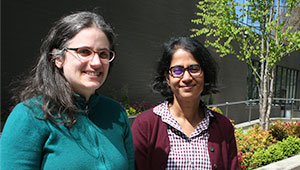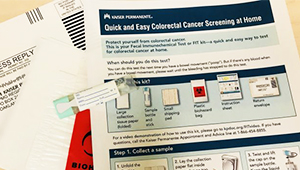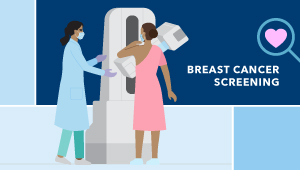Improving reporting of cancer screening harms

KPWHRI's Aruna Kamineni, PhD, MPH, discusses her recent study on how guidelines report screening risks
Possible harms from cancer screening are inconsistently reported in guidelines, according to a new study co-led by Aruna Kamineni, PhD, MPH, an investigator at Kaiser Permanente Washington Health Research Institute (KPWHRI) and a leader in the PROSPR II national consortium (PROSPR is short for Population-based Research to Optimize the Screening Process). This reporting inconsistency makes it more difficult to weigh screening benefits against potential risks and to know when cancer screening might expose people to unnecessary harms.
The study — with co-lead Paul Doria-Rose of the National Cancer Institute and coauthors including Jessica Chubak, PhD, KPWHRI senior investigator — reviewed 33 U.S. guidelines for breast, cervix, colorectal, lung, and prostate cancer screening. The researchers evaluated how well the guidelines reported on harms. Kamineni answered questions about the work.
We usually hear messages promoting screening. Why did you look at possible harms?
Cancer screening can have benefits. We know that treatments usually work better when cancer is caught early. But screening has risks, too. Because screening tests people without symptoms, most will not have cancer. If a screen or follow-up care causes problems in a lot of these people, it may do more harm than good.
Harms can be physical, such as pain from the test or procedure, or psychological, such as anxiety about test results. They can be behavioral changes, such as disengaging with health care after a false-positive result. Screening harms can include financial costs or lost opportunities, such as from delayed appointments for other health problems.
This potential for harm is why guidelines don’t suggest screening everyone for all cancers. Instead, they seek a favorable balance between benefits and harms after considering factors including age, smoking history, family history, and other health conditions. Clinicians and patients need information about benefits and harms to understand this balance and make informed decisions about screening. People who develop clinical guidelines need the information to make recommendations for the general population.
What did you learn that could improve screening guidelines?
Many guidelines reported on harms but varied in their reporting. For example, guidelines for prostate and breast cancer screening tended to have more information about harms than guidelines about colorectal, cervical, and lung screening. Although most guidelines reported harms by age, relatively few, across cancer types, reported harms by other patient subgroups. We observed less reporting of harms that happen after screening — for example, with diagnosis and especially treatment.
Reporting about harms was hard to interpret, often stating risks as "high" or "low." We think clinicians and patients would better understand numbers, such as "1 in 1,000 people" experience a harm.
We want to be clear that people should still get their recommended cancer screening. But guidelines need more complete and standardized reporting of screening harms on par with reporting of benefits. Guidelines should state an individual's accumulated risk over years of screening. Recommendations should be clear that follow-up procedures may also carry risk. Reports on harms should include all steps of the screening and follow-up process, and how many people are affected at each step.
We call for more research, particularly about psychological harms and risks over years of screening. With more evidence, reporting benefits and harms will become more individualized by patient characteristics or screening strategy. That means we must think about how best to communicate individual trade-offs of benefits and harms so people can make informed screening decisions.
As a follow-up to this work, we're using PROSPR II data from 10 U.S. health care systems to quantify harms at screening and follow-up steps for cervical, colorectal, and lung cancer. This will help us understand how to use electronic data from the health care systems to measure safe screening care and provide evidence for some of the guideline reporting gaps we observed.
What else is PROSPR II working on?
PROSPR II works to understand the outcomes of cancer screening in community-based health care. We use patient data (without identifying information) to see how well screening programs prevent cancer and cancer-related death and how we can improve these programs.
KPWHRI collaborates to lead PROSPR II work on cervical and colorectal cancer screening processes. A recent article that I co-led with Elisabeth Beaber of Fred Hutchinson Cancer Research Center describes the PROSPR II agenda.
Cancer Research

Research funded to improve cancer screening
Drs. Kamineni and Chubak are among leaders of 2 new large PROSPR awards from NCI for cervical and colorectal cancer screening research.
Read it in News and Events.
Research to practice

Making colon cancer screening easier for patients
KPWHRI’s Kilian Kimbel reflects on how the SOS study helped pave the way for a new program to find colon cancer early.
Research

Roundup of 3 recent studies on breast cancer screening
New research spotlights overdiagnosis, MRI before surgery, and a new way of predicting breast cancer risk


